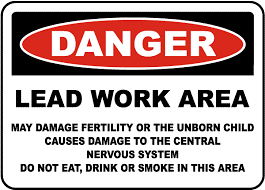|
OSHA Standard: 1926.62
Frequency of Training: Upon initial assignment and annually thereafter, or more frequently depending on change in policy, assignment, and tools used. Permissible Exposure Limit (PEL): 50 micrograms of lead per cubic meter of air, as averaged over an 8-hour period. Background: Lead (Pb) is a heavy metal that can threaten the health of workers in many occupations. Lead can be inhaled or swallowed and once inside the body tends to remain in tissue and organs. Eventually, after repeated exposures, lead build-up becomes toxic. Exposure to lead fumes and particles can come from many sources, including abrasive blasting, sanding, torch cutting, scraping, and loosening old paint with a propane torch. Dust and fumes can be inhaled, including by family members shaking out clothes. Lead can also get into the body by being transferred from dirty hands to food and drink. Serious damage can occur to your lungs, brain, liver and other organs. Children are particularly at risk for lead dust brought home from the job. How You Can Protect Yourself Lead exposure can be maintained at acceptable levels if the following practices are followed: Use an exhaust ventilation system where provided. Use a respirator that will properly protect you. Keep the worksite clean. Use only a vacuum with a HEPA filter or wet cleaning methods when removing lead dust. Never use compressed air for cleaning. Eat, drink, or smoke in areas away from the worksite. Keep all lunch boxes and coffee cups away from the work area. Use protective clothing. Store street clothes separate from work clothes. Never wear contaminated clothing home. Employer Responsibilities:
0 Comments
Your comment will be posted after it is approved.
Leave a Reply. |
AuthorSTAC Admin Categories
All
Archives
July 2024
|


 RSS Feed
RSS Feed